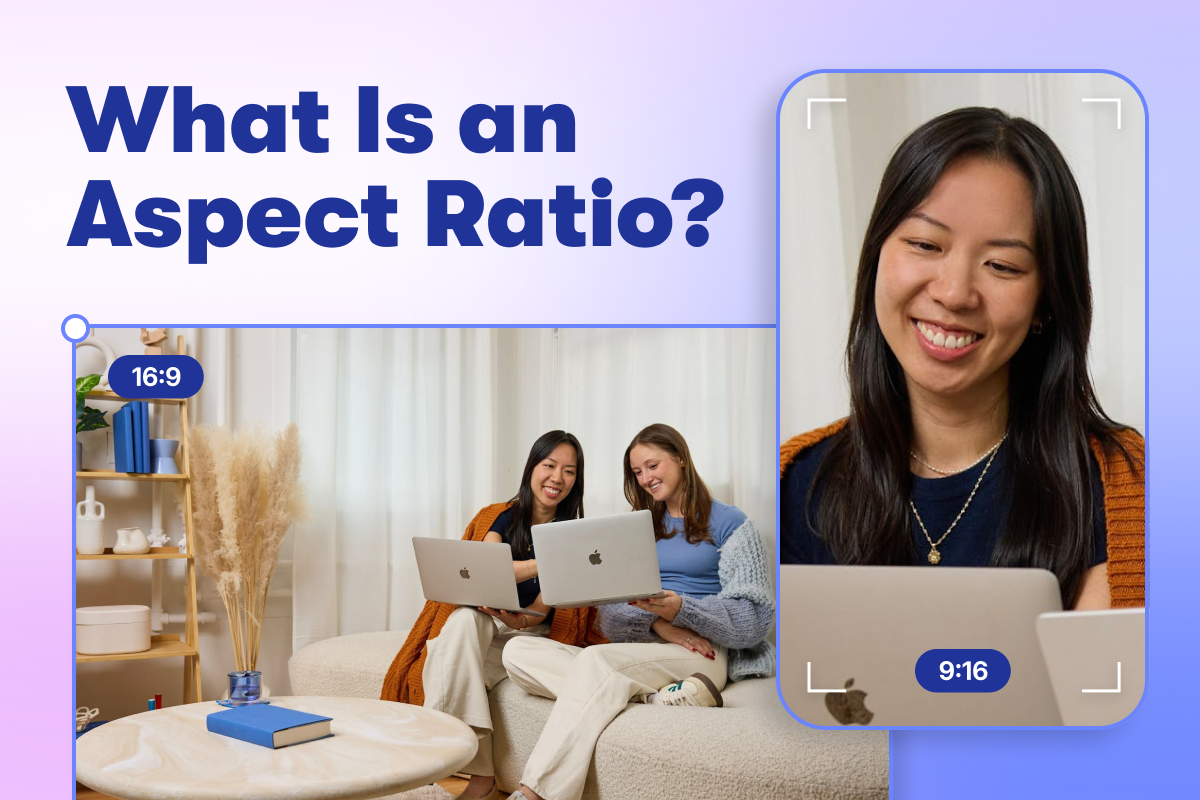What Is an Aspect Ratio?
Explore different aspect ratios and how each one impacts the look and feel of your videos.
June 12, 2025
Topic tags

An aspect ratio is the relationship between a video’s width and height. Basically, it’s the shape of your video. You’ll usually see it written as width:height, like 16:9 (widescreen) or 4:3 (a little more square).
Your video’s aspect ratio depends on two things: how the footage was shot and where it’s being watched. Watching on a phone? That’s probably vertical. On a TV? Likely widescreen. The aspect ratio shapes how your video looks and feels to the viewer.
Common aspect ratios for videos
16:9 (widescreen)
We see this aspect ratio everywhere online, like on YouTube and streaming platforms. It can also be expressed as 1.78:1.
Most DSLRs, camcorders, and mobile devices record in this format by default when shooting in landscape orientation.
9:16 (vertical)
The perfect 90-degree flip of a 16:9 video, this is the aspect ratio for vertical videos we watch on our phones. If you’re shooting a video for Instagram Reels or TikTok, this is the ideal ratio to use.
1:1 (square)
This is the only ratio where video height and width are the same. Making 1:1 videos is great for Instagram, Facebook, and some other social platforms.
4:3 (fullscreen)
Just a little wider than a square, this was the aspect ratio for the standard “fullscreen” format before widescreen TVs became more common. Video cameras made before the 2000s recorded in 4:3 .
21:9 (cinematic widescreen)
Also shown as 2.33:1, this format is often used in filmmaking to create a super cinematic feel. In filmmaking, it might also be referred to as Panavision, CinemaScope (2.35:1), or Anamorphic (2.39:1), even though each format has a slightly different ratio.
Anamorphic is a technique that lets filmmakers capture a super wide image on standard 35mm film, which normally records a more narrow picture. It basically squeezes the wide image to fit on the film, and then it gets stretched back out later during editing or playback to look widescreen.
This is used in many big-budget films to create that ultra-wide, dramatic movie feel you’re used to seeing on the big screen. When this is displayed on a 16:9 screen, you’ll see black bars (letterboxes) on the top and bottom to accommodate the wider field of view.
The difference between aspect ratio and resolution
While aspect ratio and resolution often go hand in hand, they’re not the same. The aspect ratio is the shape of your video frame (the container), and resolution is what fills that container, measured in pixels (individual points of color).
Video resolution is usually expressed as width x height, like 1920x1080, or simply 1080p. You could have a 16:9 video, but it might be 720p, 1080p, 1440p, or 2160p. Many cameras let you choose from multiple aspect ratios at the same resolution, depending on your settings.
1920x1080 (full HD)
Full High Definition (FHD) is 1080p resolution at 1920x1080 pixels in a 16:9 aspect ratio. This is the default resolution for smartphones, DSLRs, and most modern camcorders.
3840x2160 (UHD)
Ultra High Definition (UHD) is 2160p resolution at 3840x2160 pixels in a 16:9 aspect ratio. This resolution fits perfectly into a modern widescreen TV.
4096x2160 (4K UHD)
4K, also known as “DCI 4K,” is a format commonly used in professional film production. Its resolution is 4096x2160, and its aspect ratio is 1.90∶1, which is slightly wider than UHD or 16x9. When watching some Hollywood movies on a 16:9 television, you may see letterboxing at the top and bottom of your screen.
| Resolution | Aspect ratio | Pixel size | |
|---|---|---|---|
| Standard definition (SD) | 480p | 4:3 | 640x480 |
| High definition (HD) | 720p | 16:9 | 1280x720 |
| Full high definition (FHD) | 1080p | 16:9 | 1920x1080 |
| Ultra high definition (UHD) | 2160p | 16:9 | 3840x2160 |
| 4K UHD | 2160p | 1.9:1 | 4096x2160 |
Full HD is perfect for social videos, but if you want your content to stand out on Facebook or YouTube, consider shooting in UHD or 4K UHD (YouTube only).
4K and UHD are similar; many TV manufacturers and movie distributors market the terms 4K and UHD interchangeably. However, they’re slightly different. Both are 2160 pixels in height, but UHD is 3840 pixels wide and 4K is slightly wider at 4096 pixels.
Shooting with aspect ratio in mind
If you’re creating content for multiple platforms, it’s important to think ahead about how your footage might be reused. Social platforms all have different preferred aspect ratios, so shooting once and repurposing later can save time and effort.
For example, if you’re filming a one-time event like a live talk or performance, it’s a good idea to shoot a wider (landscape) frame than you think you’ll need.
Record in at least 4K resolution to give yourself room to crop the footage into different formats like 1:1, 4:5, or 9:16 for vertical viewing. This 16:9 frame gives you the flexibility to create multiple versions of the video in various ratios, while the other ratios are pretty much impossible to turn into 16:9.






